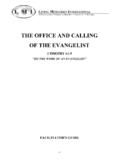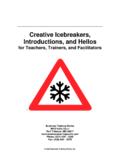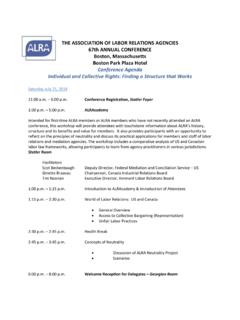Transcription of Meeting Room Configurations V3 - midwest-facilitators.net
1 Jordan-Webb - All Rights Reserved 1991-2004 - Page 1 Meeting room Configurations Guidelines for Meeting room Seating Arrangements Revision - 09/15/2004 Paul CollinsJordan-Webb(773) - All Rights Reserved 1991-2004 - Page 2 U-Shape 3 Hollow Square5 Octagon7 Team Tables or Clusters (Rectangles)9 Team Tables or Clusters (Rounds)11 Boardroom 13 Classroom15 Harvard Style Classroom (Tiered)17 Ballroom or Town Meeting19 Auditorium or Theater21 Semi-Circle23 Fish Bowl25 Electronic Meeting Support (EMS)27 Many-to-Many Web Collaboration Meeting Room29 One-to-Many Web Conferencing Meeting Room31 Combined Web Collaboration + Web Conferencing33 Meeting room ConfigurationsWe ve attempted to standardize some of the naming conventions for Meeting room seating arrangements.
2 For example, the term conference style seating is often used by hotels or conference centers to mean either U-Shape, Hollow Square or ve also included visuals for web-based distributed or virtual Meeting rooms, where there is no space nor time constraint. Wehope that you find this information useful. - - (773)-463-2288 Jordan-Webb - All Rights Reserved 1991-2004 - Page 3U-ShapeProjectorProjectorFacilitator(s) Projection Screen(s)Jordan-Webb - All Rights Reserved 1991-2004 - Page 4 The U-Shape is one of the most popular of seating arrangements for groups of up to 50participants. It features a series of rectangular tables set up in the shape of the block "U"with chairs set all around the outside perimeter. Seating is usually on the outside of the U,but it's possible to seat Participants on both inside legs of the U.
3 It is ideal for small to medium groups with a discussion or teaching format. This seatingstyle, is also optimal for training sessions and speaker presentations. It positions the leadereither in the middle of the connecting end of the U or in the middle of the U. Eachparticipant has a table or desk in front of them for taking notes and placing conferencematerial. It is also a good setup for focus groups. The openness of this setup gives each participant a sense of freedom that encourages widerparticipation, while the amount of space between participants avoids the effect ofcompression. Also there is no sense of preferential seating because all seats have anequally good view of the Meeting leaders. The U-Shape setup is often used for board of directors meetings, committee meetings, andbreakout sessions involving audio-visual presentations because all attendees can see theAV when the screen is placed at the - All Rights Reserved 1991-2004 - Page 5 Hollow SquareProjectorProjectorProjection Screen(s) facilitator (s)Jordan-Webb - All Rights Reserved 1991-2004 - Page 6 In the Hollow Square style setup, there are four or more tables arranged in a square,rectangle or other multi-sided design, in which the middle of the design is empty.
4 This setupis similar to the 'U' shaped setup and is sometimes called a closed 'U'. Participants sit onthree (or all) sides of the setup, but there is an emphasis and focus on a power figure at thehead. Each participant has the same amount of space, they can easily see one another and theyhave a writing surface. Setup is critical as far as participation is concerned. The HollowSquare is best for groups under 30 people. If the group is larger than 30, this setup might bestretched too far. If the participants can't hear or see well, there will be diminished feelings ofcollegiality. This design is good for larger committee or board meetings of 17 to 30 people, at whichinteraction among attendees is important. Avoid long, straight sections of tables over 12 feetlong.
5 Octagons and hexagons work well to improve sight lines among SquareJordan-Webb - All Rights Reserved 1991-2004 - Page 7 OctagonProjection Screen(s)ProjectorProjectorFacilitator(s )Jordan-Webb - All Rights Reserved 1991-2004 - Page 8 The Octagon (other multi-sided setup) is a variation of the Hollow Square style setup, wheremultiple tables arranged in a multi-sided design, in which the middle of the design is sit on all sides of the setup, but there is an emphasis and focus on a powerfigure at the designated head of the configuration . Each participant has the same amount of space, they can easily see one another and theyhave a writing surface. Setup is critical as far as participation is concerned. Multi-sidedsetups are best for groups under 30 people.
6 If the group is larger than 30, this setup mightbe stretched too far. If the participants can't hear or see well, there will be diminishedfeelings of collegiality. This design is good for larger committee or board meetings of 17 to 30 people, at whichinteraction among attendees is important. Avoid long, straight sections of tables over 12 feetlong. Octagons and hexagons work well to improve sight lines among - All Rights Reserved 1991-2004 - Page 9 Team Tables / Clusters - RectanglesProjectorProjectorProjection Screen(s) facilitator (s)Jordan-Webb - All Rights Reserved 1991-2004 - Page 10 Team Tables or Clusters is the setup of choice for most functions that would include mealservice in the same room . It is appropriate for small team, work group and committeemeetings.
7 Moreover, it is ideal for small breakout or study groups that require a lot of groupinteraction, discussion and/or note taking. Participants are seated at standard rectangular (single or back to back) or round tables (60",66", or 72" in diameter). Seating may be 6, 8, or 10 participants per table, depending onroom and/or table size. Depending on the needs of the session, groups can be organized as cross-functional or asdepartmental or they can be established dynamically, as needed. This setup is typicallyused where the facilitator or instructor defines sub-group work sessions or group problemsolving sessions. Due to larger numbers of participants and the amount of interaction generally seen at theseevents, additional co-facilitators are Tables / Clusters - RectanglesJordan-Webb - All Rights Reserved 1991-2004 - Page 11 Team Table / Clusters - RoundsProjectorProjectorProjection Screen(s) facilitator (s)Jordan-Webb - All Rights Reserved 1991-2004 - Page 12 Team Tables or Clusters is the setup of choice for most functions that would include mealservice in the same room .
8 It is appropriate for small team, work group and committeemeetings. Moreover, it is ideal for small breakout or study groups that require a lot of groupinteraction, discussion and/or note taking. Participants are seated at standard rectangular (single or back to back) or round tables (60",66", or 72" in diameter). Seating may be 6, 8, or 10 participants per table, depending onroom and/or table size. Depending on the needs of the session, groups can be organized as cross-functional or asdepartmental or they can be established dynamically, as needed. This setup is typicallyused where the facilitator or instructor defines sub-group work sessions or group problemsolving sessions. Due to larger numbers of participants and the amount of interaction generally seen at theseevents, additional co-facilitators are Table / Clusters - RoundsJordan-Webb - All Rights Reserved 1991-2004 - Page 13 BoardroomProjectorProjectorProjection Screen(s) facilitator (s)Jordan-Webb - All Rights Reserved 1991-2004 - Page 14 The Boardroom setup is often used for groups of 5 to 30 participants in board meetings,committee meetings, and other smaller functions at which interaction between participants isexpected.
9 Tables are set in rectangle or oval shape with chairs on both sides and ends. This is anideal setup for small discussions and/or focus groups. Participants are seated on all foursides of a table. For smaller groups of 12 of fewer, a single large conference table maysuffice. For larger groups, several 6'x30" or 8'x30" tables can be combined to create a solidrectangular - All Rights Reserved 1991-2004 - Page 15 ClassroomProjectorProjectorProjection Screen(s) facilitator (s)Jordan-Webb - All Rights Reserved 1991-2004 - Page 16 In the Classroom-style setup, participants are seated in rows of tables placed facing thefront. Long, Narrow tables are lined up in a row, one behind the other on each side of centeraisle with chairs facing head table.
10 The tables usually abut one another, although tables thatextend beyond the presentation area or stage could be angled toward the speaker in orderto provide better viewing. This is an excellent setup for between 10 and 150 participants. It is ideal in a teachingformat, or where there will be a number of speakers, panel discussion(s) and/or extensivenote taking. Classroom-style is the best setup for situations in which the presenter isexpected to do most of the talking and/or participants must take notes, refer to material inbinders, and/or work on computer equipment. It's also the most comfortable design for verylong sessions. It is not the preferred setup for encouraging conversation. The Classroom setup allows the introduction of team projects during the course of themeeting by having participants at every other group of tables turn to face those behind themto form small discussion groups.






